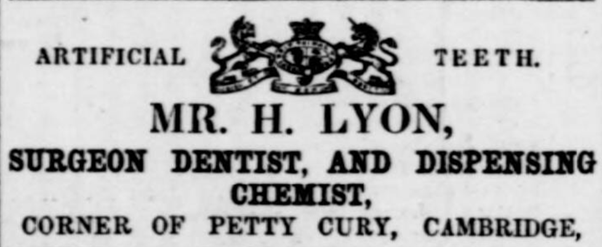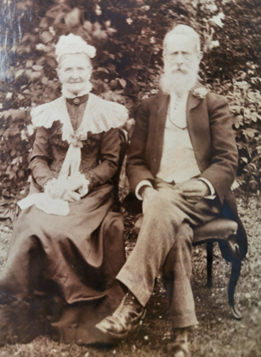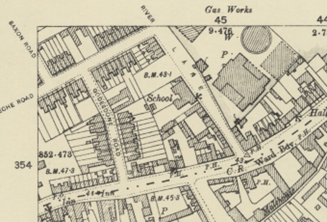In 1843, at fourteen years of age, Josiah Chater moved from Saffron Walden to Cambridge to take up a draper apprenticeship. He lived on St Mary’s Street opposite Holy Trinity Church (near present-day FatFace) and began a life in Cambridge. There were many remarkable aspects to this life, but none more intriguing to the historian than a diary he kept for forty years (1844-1884). Josiah diligently noted his daily interactions in the town he called home. This included visiting H. Lyon and Co Surgeon Dentists on the corner of Petty Cury. The young man was finally confronting a painful toothache that ‘oil of tar’ could not remedy.[i] There was nothing for it. It was finally extracted at 2 shillings, an expensive sum for a draper’s apprentice.

Example of an advertisement for the Dental Surgeon on Petty Cury, Cambridge Independent Press, 7 July 1849, 2.
Reading Chater’s diaries reminds us how we share this Victorian heritage. Anyone dining at Wasabi Sushi and Bento (23 Petty Cury) will be eating in the exact location where Josiah and his fellow apprentices had their dinner to celebrate the completion of a gruelling stock take (starting at 4am and continuing into the night).[ii] Those stepping into St Andrews Street Baptist Church, Holy Trinity Church, or St Marys Church near the marketplace will find themselves in one of the many Churches frequented by Josiah. Likewise, the marketplace itself. Whilst the surroundings have changed, places like the Guildhall were a favourite attraction for the autodidact Josiah.
At the Museum of Cambridge, we are connecting with these histories through Capturing Cambridge. On this website, you can explore how Josiah Chater lived in and shaped Victorian Cambridge. His business acumen as the first chartered accountant in the town, combined with his zealous appetite for self-improvement, saw him involved in many aspects of the development of Cambridge. Places like The Cambridge Steam Laundry Company , for instance, owed their success to meeting and taking a pipe with Josiah. Likewise, the establishment of a Cambridge Young Men’s Christian Association (which held its first meeting on 1st January 1871) was made possible partly through Josiah’s unwavering support and fundraising.

Josiah and Agnes Chater on their Golden Wedding anniversary, c.1903.
His diaries also reveal how Victorians reacted to changes within the town. One example of this took place at the Gasometer Gas Works on Newmarket Road. In 1868, two local utility rivals battled to supply the town, each seeking to outcompete the other in lighting the streetlamps. Josiah captured this moment in his diary, noting how ‘we looked very brilliant’ with the streets so brightly illuminated.

Gas Works site 1901
These histories are unique and we want to unlock their potential. Enid Porter, one of the esteemed curators in the history of the Museum, and who received the diaries from one of Josiah’s descendants in 1964, began this work in her 1975 book Victorian Cambridge, Josiah Chater’s Diaries, 1844-1884. Our next step is to see the diaries made more accessible by digitizing them. We will be looking for research volunteers to help us transcribe the diaries and place these hidden histories onto Capturing Cambridge. This work will help cast Josiah’s commentaries from the diary page to the webpage.
Even the limited interactions with Josiah’s diaries have been richly rewarding. Deciphering the handwriting of a Victorian, however, presents some challenging issues. Letters, like ‘p’, ‘b,’ ‘s’ can all appear very differently to modern audiences. Whilst cracking these palaeographical problems can be time-consuming, it is highly rewarding. The example below is taken from a teenage Josiah’s list of ‘Riddles and Conundrums’ he wrote down at the back of his second diary.

Why is an E like an Island? It is in the midst of the sea
Once transcribed you are reconnected with the life of someone who lived over 150 years ago. It brings back the life of someone who had, at times, to make difficult decisions, such as whether to take into his family home and care for a pregnant but unmarried young woman (he did). Other times, the diaries offer the mundane, such as Josiah noting the weather or the temperature of his bathwater. Taken together, these eighteen diaries uncover an intimate portrait of a Victorian and his surroundings – spaces we now inhabit.
If you would like to learn more about Josiah Chater and the histories of Cambridge, visit Capturing Cambridge.
[i] Enid Porter, Victorian Cambridge (Unwin Brothers: Surrey, 1975), 4.
[ii] Ibid, 9.